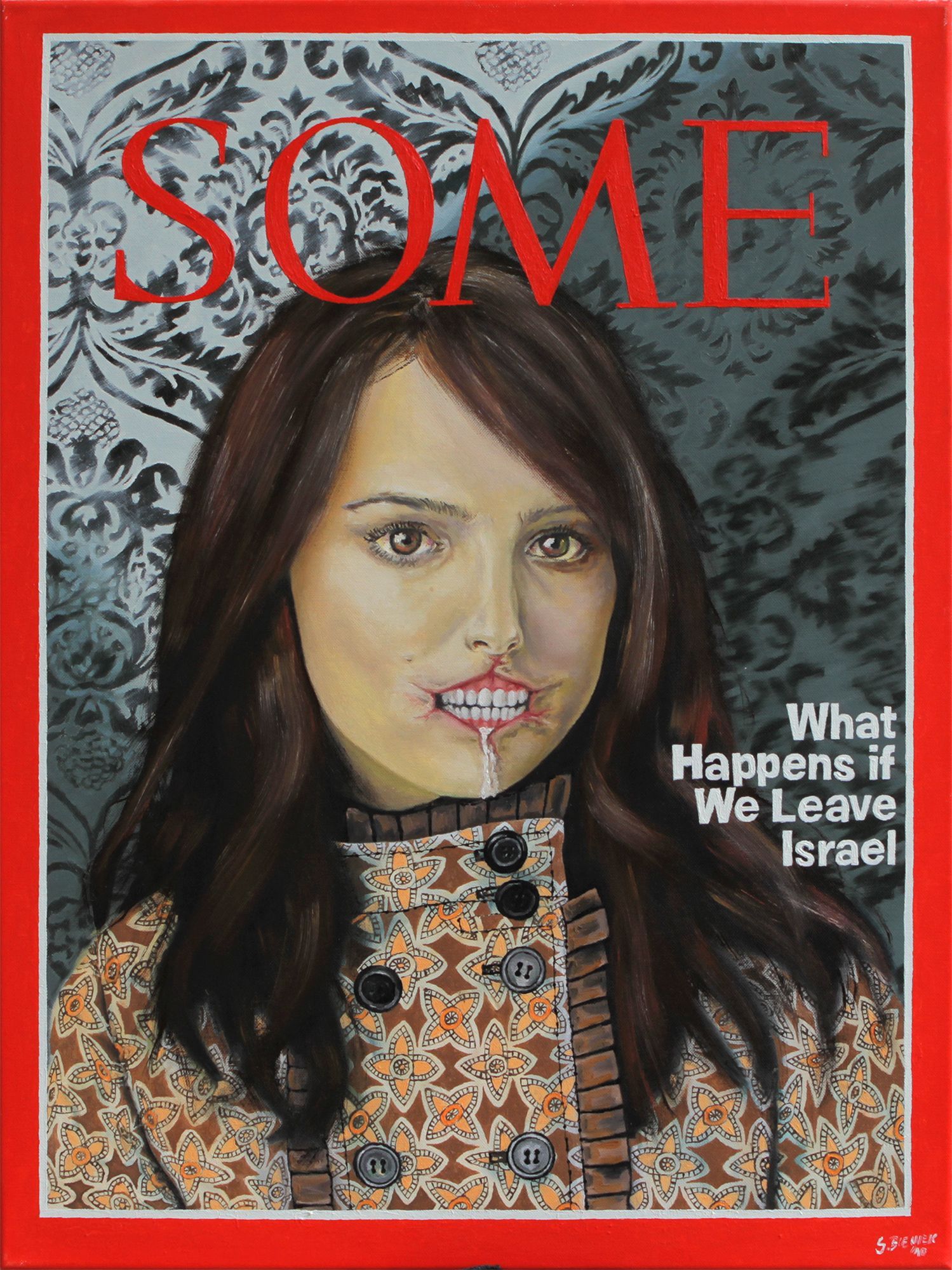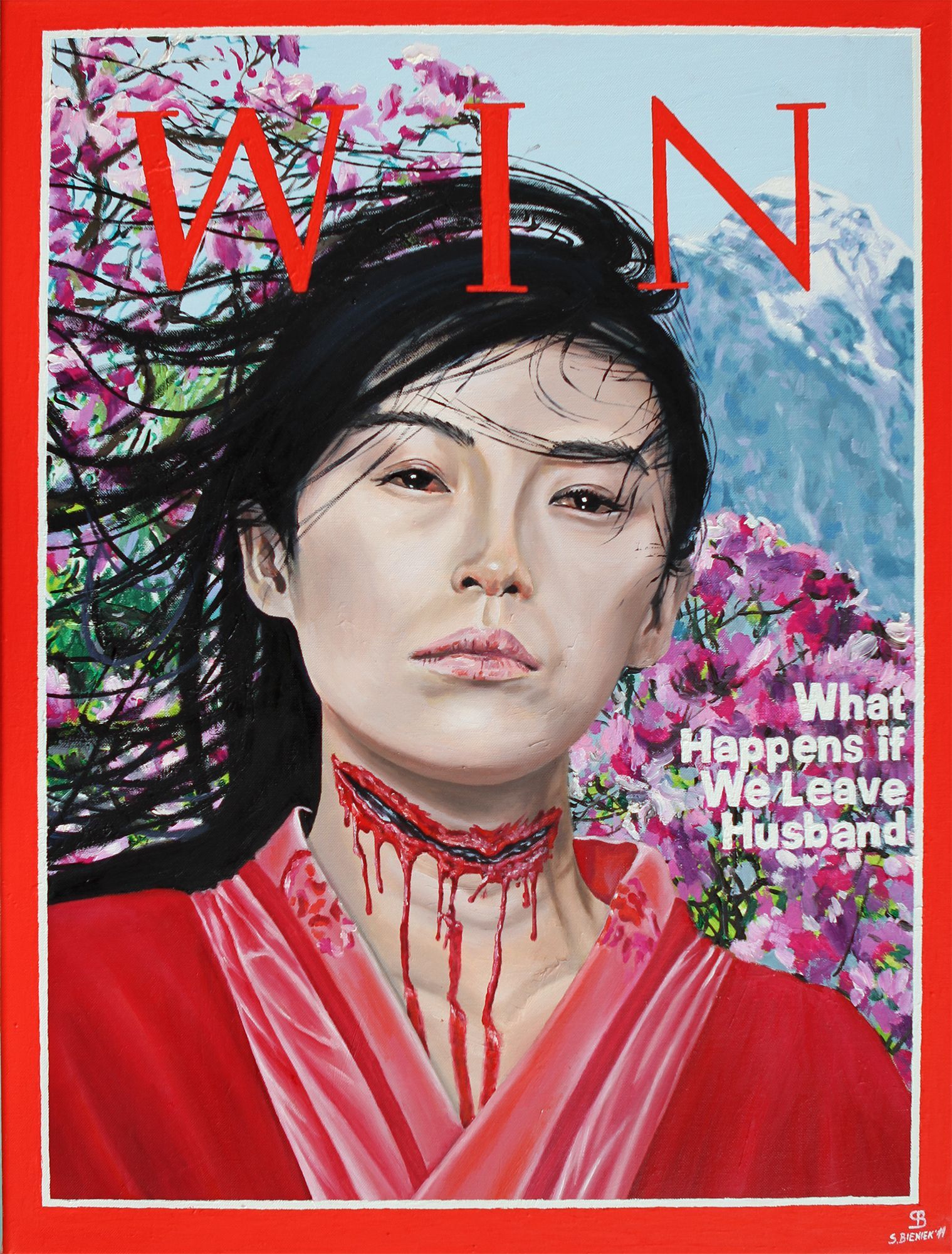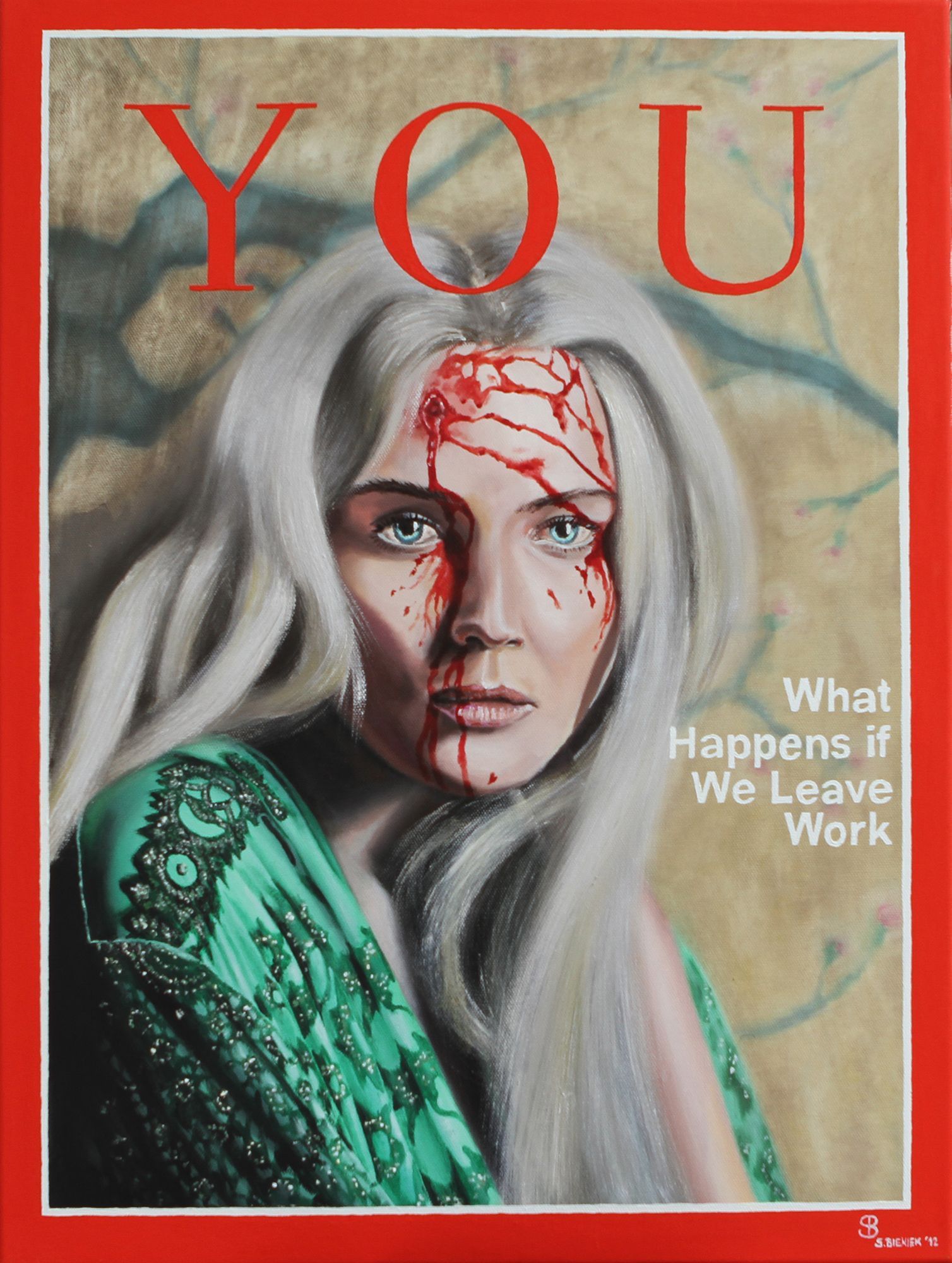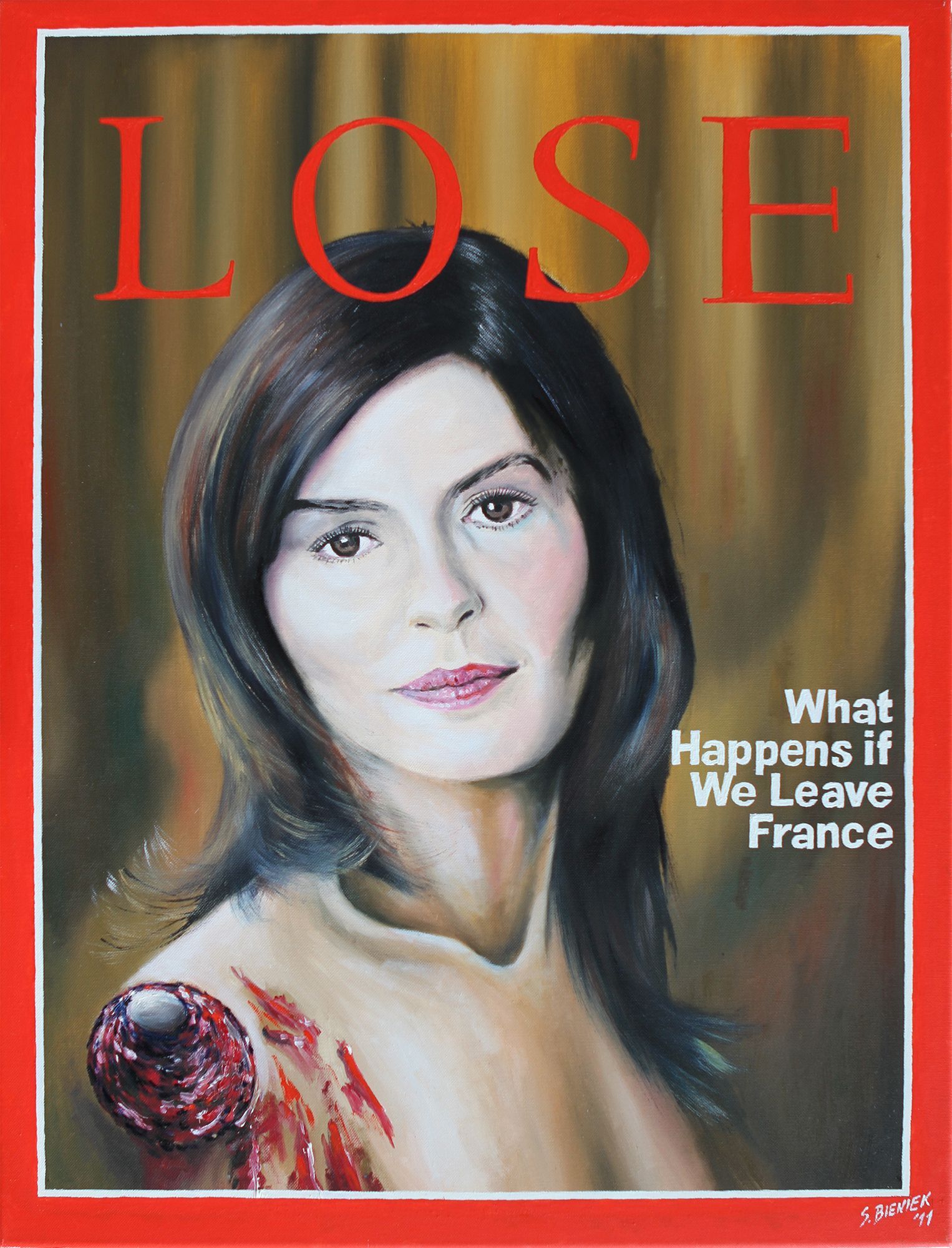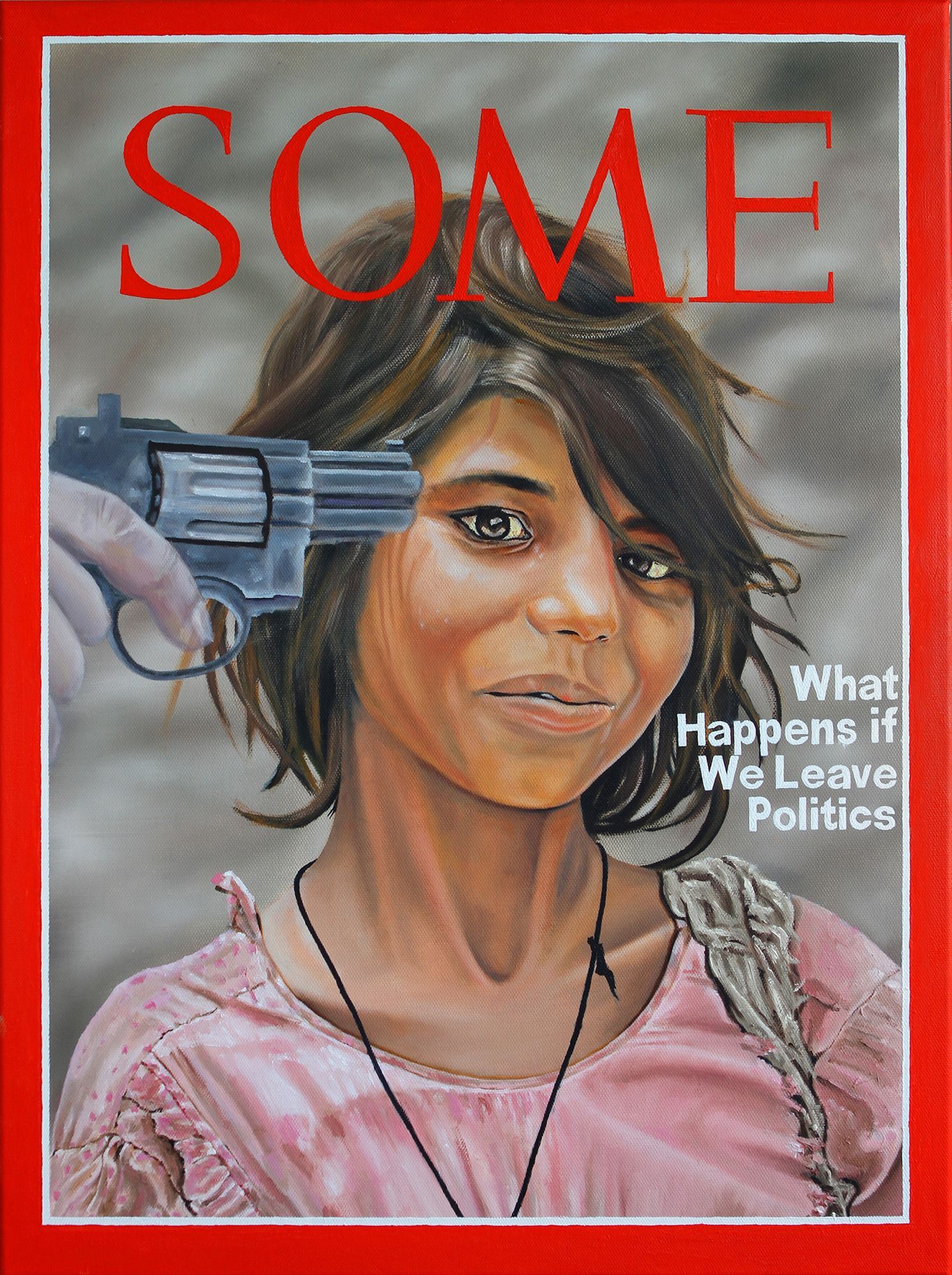"Homeland Security" by Sebastian Bieniek 2010

"Homeland Security", series of 14 paintings by Sebastian Bieniek 2010.
("Some Times You Win, Some Times You Lose, Some Always Win, Some Always Lose")
The concept (english):
An Artistic Row of 14 paintings:
As I was walking along a street in the summer of 2010, I saw the cover page of the Times magazine in front of a newsstand, with a picture of a beautiful young Afghan woman with her nose cut-off. Next to it was the headline "What happens if we leave Afghanistan." At first I was moved by the image. This picture was incredibly effective. A few minutes later I thought, "I have already seen women mutilated like this in Pushkar and Mumbai. Even at that time the mutilation of women had really shocked me, but it had not moved me as much as this Afghani woman. But actually why? The women in India were older and not beautiful. However, the Afghan woman was young and beautiful.
People who have been to India would often have already seen women with their noses cut-off. Women with a severed nose would stand begging on every corner where tourists pass by. Yet India is - in contrast to Afghanistan, which portrays the image of a terrorist country - the land of Gandhi. A nice, democratic, enlightened country ... No one thinks badly of India or wants to march into India to free these women or do something similar to that. No-one is interested in thousands of mutilated Indian women despite the fact that everyone know about it and has seen pictures or heard about it. It has probably been this way for thousands of years. Although the picture of this mutilated woman was photographed in Afghanistan, the original starting place of the mutilation of women probably came from India.
The photo on the front page of The Times suggests to me that there is a direct connection between the U.S. military presence in Afghanistan and beautiful women with their noses cut off. "What a nonsense? How can one pretend that a military intervention could change anything in this picture, have an affect, or influence it at all?’ However, it works. It worked for me too. I saw the picture, read the text beneath it and could only see the text/ image statement as one thing. It was such a strong visual statement that I turned back to the kiosk to buy a copy of this Times edition for myself.
With the issue in my hand, I went on thinking: "This special graphic image method links things together that actually have nothing to do with each other. But when they’re ones linked with such a strong image, they seemed to be the same and could not be taken apart again.
Take a picture with a very strong image and combine it with any purpose you want, and suddenly the purpose you wanted has a special urgent moralistic mission. It is a political issue. It is something that must be immediately attended to. It is a particular path that must be followed - as the way of the hero in a Hollywood-blockbuster – in order to save the world. Like speaking out the words from a Joseph Campbell book (about rules how to write fairy tales) to save a beautiful princess. This way, not only the beautiful woman would be saved, but at the same time everyone who follows the same path will become a hero.
You can find the "Homeland Security" series also as NFT on the foundation.app nft marketplace.
What annoyed me the most in this combination of image and purpose, was the fact that neither this beautiful Afghani woman or any of the Afghani people would be saved with by such image-purpose link, but entirely the opposite. These links had the aim of securing the existing power structure and thereby allegedly preventing any human rights violations.
What is to be understood about this?
The significance of this picture was to simply to say: "If something was changed, beautiful women would have their noses cut off. It is therefore better if everything stays as it is, "On one hand that means that the existing power relations will remain, and on the other hand, that - if it is so - more beautiful women will have their noses cut off. So it will have the opposite effect to what it really intended..
(I think in this context : "Man is not an island. You look at the outcomes first, then you change something. If you want to revolutionize anything, it does not really matter at what point you start doing it. If one wants to bring about a change in Kabul, the easiest way would probably be to change something in New York. However, the worst thing is - if you want to change something – but then just keep it the way it is, because then you don’t change anything at all ").
The more I thought about it, the angrier I became, because I still came to the same conclusion that the organizers misused the picture-purpose link on the front page of ‘The Times’ and people do it elsewhere in the media as well, without any regard for the real purpose or the ethics involved. There are even "phoney causes" following such a pattern as "Free the beautiful princess (or worse, children) in a distant land" just get hold of something and set up a phoney purpose because these pseudo causes always have a special exposure story, and always have a plea like " The princess wants to be liberated" This is how they begin and they continue on and on, very often just to increase the sales of newspapers or to increase the ratings of TV channels. Have you ever known a princess who wanted to know which hero would come to free her?
Underneath all of this "production" of stories, which is established by the existence of the media, is something deeper which is nothing but the pure, old and grey conservatism. With new stories having to be produced all the time, they use the old ones and over again. The dusty, old, unpopular themes and overriding systems need to be shown in a new light again and again to become popular in order to find an explanation which would make things clear to the "youth" and show them that everything must remain as it is.
Therefore, it doesn’t matter if things which are shown are beautiful or not, it is the image portrayed that is the main thing. Beauty - which is often elevated to an untouchable public domain - seems to serve as an instrument of equalization. It is a fact that people usually instinctively agree as to what is beautiful and what is not beautiful and that they feel offended, if a beautiful thing is not admired. It appears that in order for our hearts to be moved, people should be portrayed as being beautiful and not ugly. In order to visualize and to make this fact clear, I have painted beautiful people and not average people.
I have painted the most powerful images to show how the use of powerful images can cause things to be reinterpreted another way. Therefore - in the broadest sense- sometimes you win, sometimes you lose, some always win, some always lose.
This principle explains how all the banks, science, religion and the media work.
Our society is a society of fear because it is forced to search for a raison d'etre (a reason for living) through the media, business, politics and science. All people who work as journalists, politicians, doctors, scientists, almost every profession, are paid to present the question "What happens if something changes?" – to create fear.
In addition, I may add that the paintings and statements were put together arbitrarily by me. I have not painted the series in order to point out the worst things that happen in the world, but I have set them alongside each other to show how "the worst things in the world" can be misused by the media and how commercial gain can be collected and how conservatism can be criticized and things be shown in a new light.
Of course there is too much terrible misfortune in this world, and naturally it is important and commendable to have discussions about how to prevent these terrible things. However, to turn this into a business or to try to satisfy demands by emphasizing terrible things or making them appear bigger or worse than they are and keep repeating things, can produce even more misery. This is really going too far.
In some places life is very hard and unjust. That has always been the case. In the past it probably wouldn’t have been possible to raise as much money from this inequality as it is today. Whether it is governments, government organizations, NGOs, businesses, or individuals from show business, everything seems to be attracted to do something about the misery in this world. Everyone who wants to wave his flag will be recorded by the cameras and immortalized as the world saviour. Incidentally, how reliable are TV or radio broadcasts, new films, new albums, medication, products, and - not infrequently even weapons – which are promoted and sold off in exchange for raw materials and resources. But actually, on whose shoulders does this responsibility fall? And who are the real victims of it? Who is the person who wins and who remains the eternal loser? It doesn’t matter how many TV stations, politicians, superstars or accomplices come to shake the victims’ hands, and what does his photo on the front page of magazines mean, which in the end only increases the sale of the magazine and the reader is left with the feeling: "Well, I'm still lucky because I live here in Germany or the United States. From George Bush, McDonalds, RWE, the Church or Angela Merkel, who of these determine that my world is most likely to be a gift to appreciate and honour, when I look at the world "out there" and wonder what might happen to me without Angela Merkel."
I can remember having seen an award-winning photo series nearly a decade ago. Here, African children, who were slaughtered in the middle of the road, were shown in the photos. When I saw the photos, I wondered: "What did the photographer do about this then? The child had just been killed before his eyes. He must have only been a few steps away from the child. If he had intervened at that moment, he could have saved the child’s life. But he did not. He only took photos of how a child was killed before his eyes, and got the World Press Award. Yes, it is said that a photograph on the front page of ‘The Times’ will be more help than saving one human life. I think this is utter nonsense. The photo only helps the photographer of the newspaper and he reproduces copies to the organizers of the World Press Award. After all the funds and payments have been distributed to all of those who idly stood by watched the child’s death and after they have all held up their champagne glasses congratulating each other at their charity receptions, the child will very quickly be forgotten. Then next year there will be another whole new, terrible, urgent catastrophe. This is what they have to report about more than anything else, they will say then, because it is new disaster, extra money and donations will need to be given and cause more profit to be gained. This is like an automobile show where a new car model comes out each year. It seems the press, politicians, and the economy (what I call conservatism) live off the miseries and catastrophes of this world. It doesn’t seem to me as if they are their opponents, but the things which feed them.
Written by Sebastian Bieniek in 2010.
"Painting No. 1" (of 14)
"SOME" (What Happens if We Leave Israel) by Sebastian Bieniek, 2010. Oil on canvas. 80 cm. x 60 cm.
"Painting No. 2" (of 14)
"TIME" (What Happens if We Leave Afghanistan) by Sebastian Bieniek, 2010. Oil on canvas. 80 cm. x 60 cm.
"Painting No. 3" (of 14)
"YOU" (What Happens if We Leave School) by Sebastian Bieniek, 2011. Oil on canvas. 80 cm. x 60 cm.
Das Konzept (deutsch/german):
Als ich im Sommer 2010 eine Straße lang ging habe ich vor einem Zeitungskiosk das Deckblatt des TIMES Magazins gesehen auf dem eine junge schöne Afghanin mit einer abgeschnittenen Nase zu sehen war. Daneben stand „What happens if we leave Afghanistan“. Ich war zunächst von dem Bild bewegt. Dieses Bild hatte eine unglaubliche Kraft. Einige Minuten später dachte ich: „ Ich hatte doch bereits in Pushkar und Bombay derart verstümmelte Frauen gesehen. Damals hatten die Verstümmelungen der Frauen mich zwar auch geradezu erschreckt, aber beim weiten nicht so bewegt wie diese Afghanin. Warum eigentlich? Die Frauen in Indien waren älter und nicht schön. Die Afghanin war dagegen jung und schön.
Wer schon mal in Indien war der wird schon öfter Frauen mit abgeschnittenen Nasen gesehen haben. In Indien sah man das sehr oft. Frauen mit abgeschnittenen Nasen bettelten dort an jeder Ecke an der Touristen vorbeizogen. Und trotzdem war Indien - im Gegensatz zu Afghanistan welches das Image eines Terroristenlandes genoss - das Land von Ghandi. Nett, demokratisch, aufgeklärt... Niemand machte wegen der vielen Frauen mit abgeschnittenen Nasen Indien schlecht oder wollte in Indien einmarschieren sie zu befreien oder der gleichen. Die Tausende von verstümmelten Frauen Indiens interessierten niemanden und das obwohl eigentlich jeder davon wusste und obwohl dies so wahrscheinlich schon seit Jahrtausenden zum Indienbild dazugehörte und obwohl dieses Bild der Frauendemütigung, welches in Afghanistan abfotografiert wurde wahrscheinlich seine Ursprünge in Indien hatte.
Das Foto auf der Titelseite der Times suggerierte nur, dass es einen direkten Zusammenhang zwischen den USA, der militärischen Anwesenheit der USA in Afghanistan und schönen Frauen mit abgeschnittenen Nasen gab – alles andere klammerte es aus. „Wie kann man denn nur diese zwar Aussagen in einen so direkten Zusammenhang bringen. So tun, als würde eine Militärintervention überhaupt irgendetwas an diesem Bild verändern. Es beeinflussen, oder es überhaupt beeinflussen wollen? Und trotzdem. Es funktionierte. Es funktionierte auch bei mir. Ich sah das Bild, las den Text daneben und konnte nicht anderes als die Text-und Bildaussage als Eines zu lesen. Und das so stark und eindringlich“, dachte ich und kehrte wieder zurück zu dem Kiosk um mir die Times-Ausgabe zu kaufen.
Mit dem Heft in der Hand dachte ich weiter: „Diese Kunst Dinge miteinander zu verknüpfen, die eigentlich gar nichts miteinander zu tun haben, die heißt doch Politik. Man nehme ein Bild welches sehr stark ist und knüpfe ein beliebiges Ziel daran und plötzlich wird dieses Ziel ein moralisches und absolut notwendiges. Ein Politikum. Etwas das sofort erledigt werden musste. Ein Weg der beschritten werden muss – wie in einem hollywood-blockbuster – um die Welt zu retten. Wie in der Anleitung zum Drehbuchschreiben nach Joseph Cambell um die schöne Prinzessin zu retten. Dadurch konnte nicht nur die Schöne gerettet, sondern gleichzeitig jeder der diesen Weg beschritt zum Helden werden.
Was mich aber am meisten an dieser Verknüpfung von Bild und Ziel ärgerte war die Tatsache, dass nicht etwa die schöne Afghanin oder irgendeinen Afghanin mit derart Bild-Ziel-Verknüpfungen gerettet wurde, sondern ganz im Gegenteil. Diese Verknüpfungen hatten es zum Ziel die bestehenden Machtordnung zu sichern und damit auch die Menschenrechtsverletzungen, die sie angeblich verhindern wollten.
Wie ist das zu verstehen?
Die Aussage der Bilder war um es ganz einfach zu sagen: „Wenn sich etwas verändert, werden schönen Frauen die Nasen abgeschnitten werden. Es ist daher besser, wenn alles so bleibt, wie es ist.“ Das bedeutet aber doch einerseits, dass die bestehenden Machtverhältnisse erhalten bleiben und andererseits, dass – wenn es so ist – weiter schönen Frauen die Nasen abgeschnitten werden. Es bewirkte also das Gegenteil dessen was es zu bewirken vorgab („Der Mensch ist keine Insel. Ziehst du an einem Ende dann veränderst du etwas an dem anderen. Und wenn du etwas umwälzen willst, dann ist es eigentlich egal an welcher Stelle du es tust oder beginnst. Am leichtesten ist es wahrscheinlich etwas in New York zu verändern, wenn man eine Veränderung in Kabul herbeiführen will. Das Schlimmste ist aber – wenn du etwas verändern willst – alles so zu belassen wie es ist, denn damit veränderst du gar nichts“, denke ich in diesem Zusammenhang).
Umso mehr ich darüber nachdachte, desto wütender wurde ich, denn ich kam immer mehr zu dem Schluss, dass das Mittel der Bild-Ziel-Verknüpfung auf der Titelseite der Times und auch andernorts von den Medien ohne jeder Rücksicht auf das Ziel oder die Ethik missbraucht wird. Es werden sogar „Pseudoziele“ nach dem Muster „Befreie die schöne Prinzessin (oder noch schlimmer: Kinder) in einem fernen Land“ nur dazu hergestellt und ein Pseudoziel aufzubauen, weil diese Pseudoziele waren auch immer die Expositionen von Geschichten, die immer mit der „Prinzessin die befreit werden wollte“ begannen und die immer weiter fortgesetzt wurden, sehr oft nur um die Verkaufszahlen von Zeitungen oder Einschaltquoten von TV-Sendern zu erhöhen. Kannten man erst einmal die Prinzessin, wollte man wissen, welcher Held es schaffen würde sie zu befreien.
Unter all dieser „Produktion“ von Geschichten, die das Dasein von Medien begründeten steckte aber noch etwas Tieferes und das war nichts anders als der pure, alte und vergraute Konservatismus. Mit immer neuen Geschichten musste das alte immer wieder neu begründet werden. Die alten unpopulär und verstaubt wirkenden Ziele und Ordnungen brauchten immer wieder neue Kleider um populär zu werden um eine Sprache zu finden mit der die „Jugend“ sprach und mit der der Jugend klargemacht werden konnte, dass alles so bleiben muss, wie es ist.
Davon und davon, dass es nicht egal ist, ob das Dargestellt schön ist oder nicht, handelt diese Gemäldereihe. Die Schönheit – die oft zu einem unantastbaren Allgemeingut erhoben wird – scheint mit dabei als ein Gleichschaltungsinstrument zu dienen. Durch die Tatsache bereits, dass Menschen unwillkürlich darin übereinstimmen was schön und was nicht schön ist und dass sie sich selbst verletzt fühlen, wenn die Schönheit verletzt wird, scheint mir begründet warum es schöne und nicht hässliche Menschen sein müssen, die unser Herz so sehr zu bewegen vermögen. Um das zu visualisieren und zu verdeutlichen habe ich Schönheiten und nicht Durchschnittsmenschen gemalt.
Ich habe möglichst starke Bilder gemalt, um zu zeigen wozu starke Bilder benutzt und wie sie umgedeutet werden. Damit – im weitesten Sinne - immer die selben verlieren und immer die gleichen gewinnen. Das ist das Prinzip für welches die Politik, die Banken, die Wissenschaft, die Religion und die Medien arbeiten.
Unsere Gesellschaft ist eine Angstgesellschaft, weil sie durch die Medien, Wirtschaft, Politik und Wissenschaft – die nach ihrer Daseinsberechtigung suchen - dazu gemacht wird. Man wird als Journalist, Politiker, Arzt, Wissenschaftler, nahezu in jeden Berufszweig dafür bezahlt an die Frage „Was passiert wenn sich etwas verändert?“ Ängste zu knüpfen.
Daneben will ich noch anführen, dass die Bilder und Aussagen beliebig von mir zusammengestellt wurden. Ich habe die Serie nicht gemalt um auf das schlimme, das in der Welt passiert hinzuweisen, sondern um mich damit auseinanderzusetzen wie „das schlimme in der Welt“ medial missbraucht werden kann und wie es zum Handelsgut erhoben wird und um den Konservatismus damit zu kritisieren, der hier neu bekleidet wird.
Natürlich gibt es viel zu viel schrecklichen Elend auf dieser Welt und natürlich ist es gut und wichtig sich damit auseinanderzusetzen, dem vorzubeugen oder es zu verhindern. Dies aber zu einer Industrie zu machen und womöglich um diese Industrie am laufen zu halten um die Nachfrage zu stillen noch mehr Elend zu produzieren, es vergrößern oder sogar herauszustellen, das geht zu weit.
Das Leben ist manchenorts sehr hart und ungerecht. Das ist es schon immer gewesen. So viel Geld durch diese Ungleichheit war aber wohl noch nie zu verdienen möglich gewesen wie heute. Ob Regierungen, Regierungsorganisationen, NGO’s, Wirtschaftsunternehmen oder manche Einzelpersonen aus dem Showbusiness, alles scheint von dem Elend dieser Welt angezogen zu werden. Alles schreibt es sich selbst auf die Fahne will als der Weltenretter von den Kameras festgehalten und verewigt werden. Und wie zufällig wird nebenbei ein Sender, Sendung, der neue Film, das neue Album, ein Medikament, ein Produkt – nicht selten sogar Waffen – promotet oder die Rohstoffförderungsrechte verschachert. Aber auf wessen Schultern eigentlich? Und was haben die tatsächlichen Opfer davon? Wer ist denn derjenige der dabei gewinnt und der, der ewige Verlierer bleibt? Ganz egal wie viele TV-Sender, Politiker, Superstars, Helfershelfer den Opfern die Hand zu schütteln kommen und was seinen Platz auf den Titelseiten der Magazine findet, am Ende steigen nur die Verkaufszahlen der Magazine und der Leser bleibt mit dem Gefühl zurück: „Na, da habe ich aber noch einmal Glück gehabt, dass ich hier in Deutschland oder den USA lebe. Ein George Bush, McDonalds, RWE, die Kirche oder Angela Merkel, das also was meine Welt bestimmt, ist wohl mehr als ein Geschenk zu bezeichnen und zu ehren, wenn ich mir das ansehe, was in der Welt „da draußen“ passiert und was mir ohne der Angela Merkel zustoßen würde“.
Ich kann mich erinnern vor fast zehn Jahren eine preisgekrönte Fotostrecke gesehen zu haben. Auf den Fotos waren afrikanische Kinder, die sich mitten auf der Straße abgeschlachtet hatten, zu sehen. Als ich das Foto sah, fragte ich mich: „Aber was hat denn der Fotograf währenddessen getan? Das Kind das da gerade vor seinen Augen erschlagen wurde, muss nur wenige Schritte von ihm entfernt gewesen sein. Würde er in diesem Moment dazwischen treten, könnte er das Leben des Kindes retten. Aber er tat es nicht. Er machte nur Fotos davon, wie ein Kind vor seinen Augen erschlagen wurde und bekam dafür den World Press Award. Ja, man sagt, dass ein Foto auf der Titelseite der Times mehr hilft als das Retten eines Menschenlebens. Ich sage: völliger Blödsinn. Das Foto hilft nur dem Fotografen, der Zeitung die es abdruckt und den Veranstaltern des World Press Award. Das Kind wird neben all den Preisen, Geldern, die an die verteilt werden, die tatenlos seinem Sterben zusahen und sich Sektgläser haltend gegenseitig auf Wohltätigkeitsempfängen beglückwünschen, ganz schnell vergessen werden. Und im nächsten Jahr wird es wieder eine ganz neue, ganz schreckliche und ganz wichtige Katastrophe geben. Über sie wird man mehr als über alles andere berichten müssen, wird es dann heißen, denn dafür wird es neues, frisches Geld und neue Preise die es zu gewinnen gilt geben. So wie eine Automobile-Messe davon lebt, dass jedes Jahr neue Automodelle rauskommen, scheint die Presse, Politik und Wirtschaft (das was ich Konservatismus nenne) von dem Elend und den Katastrophen dieser Welt zu leben. Diese scheinen mir nicht ihre Gegner, sondern ihr Nahrungsmittel zu sein.
Sebastian Bieniek (2010)
"Painting No. 4" (of 14)
"WIN" (What Happens if We Leave Husband) by Sebastian Bieniek, 2011. Oil on canvas. 80 cm. x 60 cm.
"Painting No. 5" (of 14)
"SOME" (What Happens if We Leave Parents) by Sebastian Bieniek, 2011. Oil on canvas. 80 cm. x 60 cm.
"Painting No. 6" (of 14)
"TIME" (What Happens if We Leave Forest) by Sebastian Bieniek, 2011. Oil on canvas. 80 cm. x 60 cm.
"Painting No. 7" (of 14)
"YOU" (What Happens if We Leave Work) by Sebastian Bieniek, 2012. Oil on canvas. 80 cm. x 60 cm.
"Painting No. 8" (of 14)
"LOSE" (What Happens if We Leave France) by Sebastian Bieniek, 2011. Oil on canvas. 80 cm. x 60 cm.
"Painting No. 9" (of 14)
"SOME" (What Happens if We Leave Home) by Sebastian Bieniek, 2012. Oil on canvas. 80 cm. x 60 cm.
"Painting No. 10" (of 14)
"ALWAYS" (What Happens if We Leave Childhood) by Sebastian Bieniek, 2012. Oil on canvas. 80 cm. x 60 cm.
"Painting No. 11" (of 14)
"WIN" (What Happens if We Leave Banks) by Sebastian Bieniek, 2011. Oil on canvas. 80 cm. x 60 cm.
"SOME" (What Happens if We Leave Politics) by Sebastian Bieniek, 2011. Oil on canvas. 80 cm. x 60 cm.
"ALWAYS" (What Happens if We Leave Media) by Sebastian Bieniek, 2011. Oil on canvas. 80 cm. x 60 cm.
"LOSE" (What Happens if We Leave To Leave) by Sebastian Bieniek, 2011. Oil on canvas. 80 cm. x 60 cm.
I. Related links (Homeland Security NFT):
- Homeland Security on foundation.app
- Homeland Security on Etherscan
- Homeland Security on opensea
- Homeland Security on rariable
- Homeland Security on nftgo.io
- Homeland Security on element.market
- Homeland Security on x2x2.io
- Homeland Security on looksrare.org
- Homeland Security on zora.co
- Homeland Security on nft.coinbace.com
- Homeland Security on mintable.com
- Homeland Security on okx.com
- Homeland Security on pro.opensea.io
- Homeland Security on zapper.xyz
- Homeland Security on eth.info
- Homeland Security on coinstats.app
- Homeland Security on app.nfttrack.ai
II. Related links (social media):
III. Related links (reviews & others):
- Following series...


